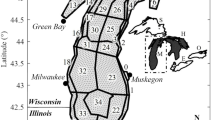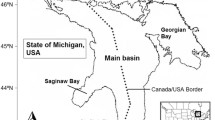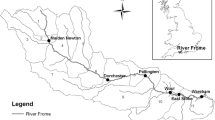Abstract
A Lake Michigan Ecosystem Model (LM-Eco) that includes a detailed description of trophic levels and their interactions was developed for Lake Michigan. The LM-Eco model constitutes a first step toward a comprehensive Lake Michigan ecosystem productivity model to investigate ecosystem-level responses and effects within the lower food web of the lake. The effect of the invasive species Bythotrephes longimanus on individual zooplankton species was investigated based upon extensive field data collected at multiple locations in Lake Michigan during the 1994–1995 Lake Michigan Mass Balance Study. Field data collected at 15 sampling stations within Lake Michigan over a series of 8 sampling cruises throughout a 2 year period demonstrated that over 65% of zooplankton species exhibited a decline with the occurrence of Bythotrephes in the sample. The LM-Eco model was successfully applied to simulate the trends of Bythotrephes and zooplankton abundance as observed in the collected field data. Model simulations allowed for examination of interactions between the invader Bythotrephes and native zooplankton groups on a 5 km by 5 km resolution throughout Lake Michigan. Analysis was completed as a time series specific to individual field sampling locations within the lake, and also on a lake-wide scale.




Similar content being viewed by others
References
Barbiero RP, Tuchman ML (2004) Changes in the crustacean communities of Lakes Michigan, Huron, and Erie following the invasion of the predatory cladoceran Bythotrephes longimanus. Can J Fish Aquat Sci 61:2111–2125
Beletsky D, Schwab DJ (1998) Modeling thermal structure and circulation in Lake Michigan. In: Abstracts of the estuarine and coastal modeling fifth international conference, Alexandria, 22–24 Oct 1997
Bierman VJ, Dolan DM (1981) Modeling phytoplankton-nutrient dynamics in Saginaw Bay, Lake Huron. J Gt Lakes Res 7:409–439
Bierman VJ, Dolan DM (1986) Modeling of phytoplankton in Saginaw Bay: I. Calibration phase. J Environ Eng 112:415–429
Blumberg AF, Mellor GL (1987) A description of a three-dimensional coastal ocean circulation model. Coast Estuar Sci 4:1–6
Burkhardt S, Lehman JT (1994) Prey consumption and predatory effects of an invertebrate predator (Bythotrephes: Cladocera, Cercopagidae) based on phosphorus budgets. Limnol Oceanogr 39:1007–1019
Canale RP (1976) Modeling biochemical processes in aquatic ecosystems. Ann Arbor Science, Ann Arbor
Canale RP, Depalma LM, Vogel AH (1975) A plankton based food web model for Lake Michigan. In: Canale RP, Depalma LM, Vogel AH (eds) Modeling biochemical processes in aquatic ecosystems. Sea Grant Program, Ann Arbor
Cardinale BJ, Srivastava DS, Duffy JE, Wright JP, Downing AL, Sankaran M, Jouseau C (2006) Effects of biodiversity on the functioning of trophic groups and ecosystems. Nature 443:989–992
Cerco CF, Cole T (1995) Three dimensional eutrophication model of Chesapeake Bay. J Environ Eng 119:1006–1025
Chapman RS, Cole TM, Gerald TK (1997) Development of a hydrodynamic/water quality (POM-IPXMT) linkage for the Lake Michigan mass balance project, final report. U.S. Environmental Protection Agency, Office of Research and Development, ERL-Duluth, Large Lakes Research Station, Grosse Ile
Evans MS (1988) Bythotrephes cederstroemi: its new appearance in Lake Michigan. J Gt Lakes Res 14:234–240
Great Lakes Commission (2006) Great Lakes aquatic nuisance species. http://www.glc.org/ans/. Accessed 08 Aug 2007
Great Lakes Observation System (2007) About GLOS—The Great Lakes node of the National Integrated Ocean Observing System. http://glos.us/. Accessed 10 Dec 2007
Hassan R, Scholes R, Ash N (2005) Ecosystems and human well-being: current state and trends, vol 1, findings of the condition and trends working group of the millennium ecosystem assessment. Island Press, WA
Heiskary S, Olmanson L, Gitelson A, Chipman J (2006) Remote sensing: does it have a role? Lakeline 26:27–35
International Joint Commission (2006) Thirteenth Biennial report. http://www.ijc.org/en/publications/pdf/13br_e.pdf. Accessed 28 May 2008
Jin EH, Sprules WG (1990) Distribution and abundance of Bythotrephes cederstroemii (Cladocera: Cercopagidae) in the St. Lawrence Great Lakes. Verh Int Ver Limnol 24:383–385
Johannsson OE, Mills EL, O’Gorman R (1991) Changes in the near shore and offshore zooplankton communities in Lake Ontario. Can J Fish Aquat Sci 48:1546–1557
Lehman JT (1987) Palearctic predator invades North American Great Lakes. Oecologia 74:478–480
Lehman JT (1988) Algal biomass unaffected by food web changes in Lake Michigan. Nature 332:537–538
Lehman JT (1991) Causes and consequences of cladoceran dynamics in Lake Michigan: implications of species invasion by Bythotrephes. J Gt Lakes Res 17:437–445
Lehman JT, Caceres CE (1993) Food-web responses to species invasion by a predatory invertebrate Bythotrephes in Lake Michigan: implications of species invasion by Bythotrephes. Limnol Oceanogr 38:879–891
Leonard B (1991) The ULTIMATE conservative difference scheme applied to unsteady one-dimensional advection. Comp Methods Appl Mech Eng 88:17–74
LimnoTech (2000) Ecosystem model for the Lake Michigan mass balance study. U.S. Environmental Protection Agency, Office of Research and Development, ERL-Duluth, Large Lakes Research Station, Grosse Ile
Liu PC, Schwab DJ (1987) A comparison of methods for estimating U* from given Uz and air-sea temperature differences. J Geophys Res 92:6488–6494
Madenjian C, Fahnenstiel G, Johengen T, Nalepa T, Vanderploeg H, Fleischer G, Schneeberger P, Benjamin D, Smith E, Bence J, Rutherford E, Lavis D, Robertson D, Jude D, Ebener M (2002) Dynamics of the Lake Michigan food web, 1970–2000. Can J Fish Aquat Sci 59:736–753
Pothoven SA, Fahnenstiel GL, Vanderploeg HA (2001) Population dynamics of Bythotrephes cederstroemii in south-east Lake Michigan 1995–1998. Freshw Biol 46:1491–1501
Pothoven SA, Fahnenstiel GL, Vanderploeg HA (2003) Population characteristics of Bythotrephes in Lake Michigan. J Gt Lakes Res 29:145–156
Ricciardi A, Rasmussen JB (1999) Extinction rates of North American freshwater fauna. Conserv Biol 3:1220–1222
Richardson WL, Endicott DD, Kreis RG Jr, Rygwelski KR (1999) The Lake Michigan mass balance project quality assurance plan for mathematical modeling. US Environmental Protection Agency, Office of Research and Development, Mid-Continent Ecology Division, Large Lakes Research Station, Grosse Ile, EPA/600/R-04/018
Sala OE, Chapin FS III, Armesto J, Berlow E, Bloomfield J, Dirzo R, Huber-Sanwald E, Huenneke LF, Jackson RB, Kinzig A, Leeman RS, Lodge DM, Mooney HA, Oesterheld M, Poff NL, Sykes MT, Walker BH, Walker M, Wall DH (2000) Global biodiversity scenarios for the year 2100. Science 287:1770–1774
Sandgren CD, Lehman JT (1990) Response of chlorophyll a, phytoplankton, and microzooplankton to the invasion of Lake Michigan by Bythotrephes. Verh Int Ver Limnol 24:386–392
Scavia D, Lang GA, Kitchell JF (1988) Dynamics of Lake Michigan plankton: a model evaluation of nutrient loading, competition, and predation. Can J Fish Aquat Sci 45:165–177
Thomann RV (1982) Verification of water quality models. J Environ Eng 108:933–940
US Environmental Protection Agency (1997a) Lake Michigan mass balance study (LMMB) methods compendium, vol 1: sample collection techniques. U.S. Environmental Protection Agency, Great Lakes National Program Office, Chicago, EPA/905/R-97/017
US Environmental Protection Agency (1997b) Lake Michigan mass budget/mass balance work plan. US Environmental Protection Agency, Great Lakes National Program Office, Chicago, EPA/905/R-97/018
US Environmental Protection Agency (2001) The Lake Michigan mass balance study quality assurance report. US Environmental Protection Agency, Great Lakes National Program Office, Chicago, EPA/905/R-01/013
Vanderploeg HA, Nalepa TF, Jude DJ, Mills EL, Holeck KT, Liebig JR, Grigorovich IA, Ojaveer H (2002) Dispersal and emerging ecological impacts of Ponto-Caspian species in the Laurentian Great Lakes. Can J Fish Aquat Sci 59:1209–1228
Yurista PM, Kelly JR, Miller S (2005) Evaluation of optically acquired zooplankton size-spectrum data as a potential tool for assessment of condition in the Great Lakes. Environ Manag 35:34–44
Yurista PM, Kelly JR, Miller S (2009) Lake Superior zooplankton biomass: alternate estimates from a probability-based net survey and spatially extensive LOPC surveys. J Gt Lakes Res 35:337–346
Acknowledgments
This study was conducted in support of the Invasive Species Initiative in the Office of Research and Development (ORD) of the USEPA. We thank Peder Yurista and Henry Vanderploeg for providing a valuable review of this manuscript. The authors also wish to acknowledge the Great Lakes National Program Office for their efforts in the Lake Michigan Mass Balance Study, as well as the many cooperators during the study. In addition, the authors wish to acknowledge NOAA, GLERL, and LimnoTech for their cooperation and collaboration. The views expressed in this article are those of the authors and do not necessarily reflect the views or policies of the U.S. Environmental Protection Agency. Mention of trade names or commercial products does not constitute endorsement or recommendation for use.
Author information
Authors and Affiliations
Corresponding author
Rights and permissions
About this article
Cite this article
Miller, D.H., Kreis, R.G., Huang, WC. et al. Application of a lower food web ecosystem productivity model for investigating dynamics of the invasive species Bythotrephes longimanus in Lake Michigan. Biol Invasions 12, 3513–3524 (2010). https://doi.org/10.1007/s10530-010-9748-1
Received:
Accepted:
Published:
Issue Date:
DOI: https://doi.org/10.1007/s10530-010-9748-1




